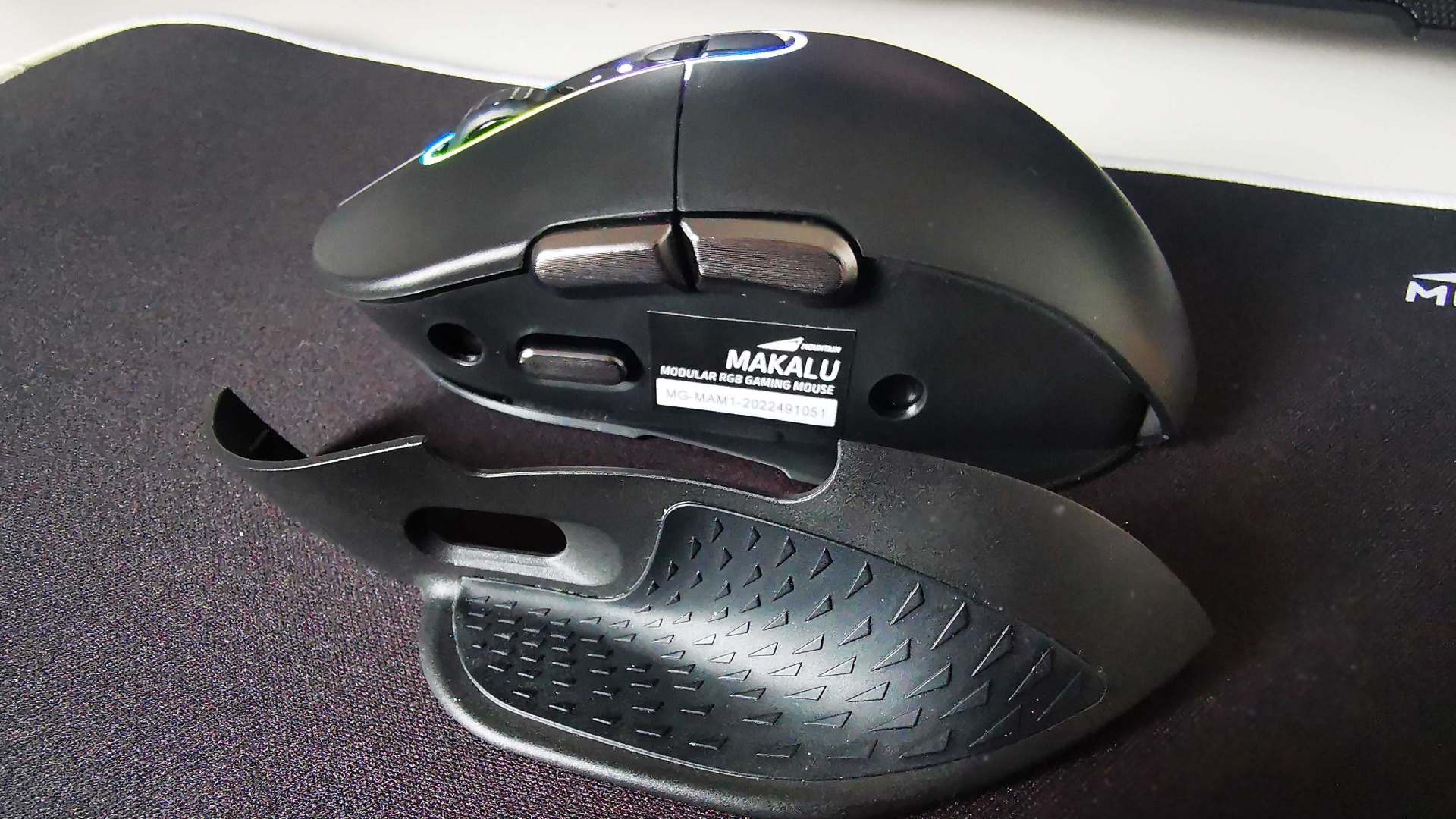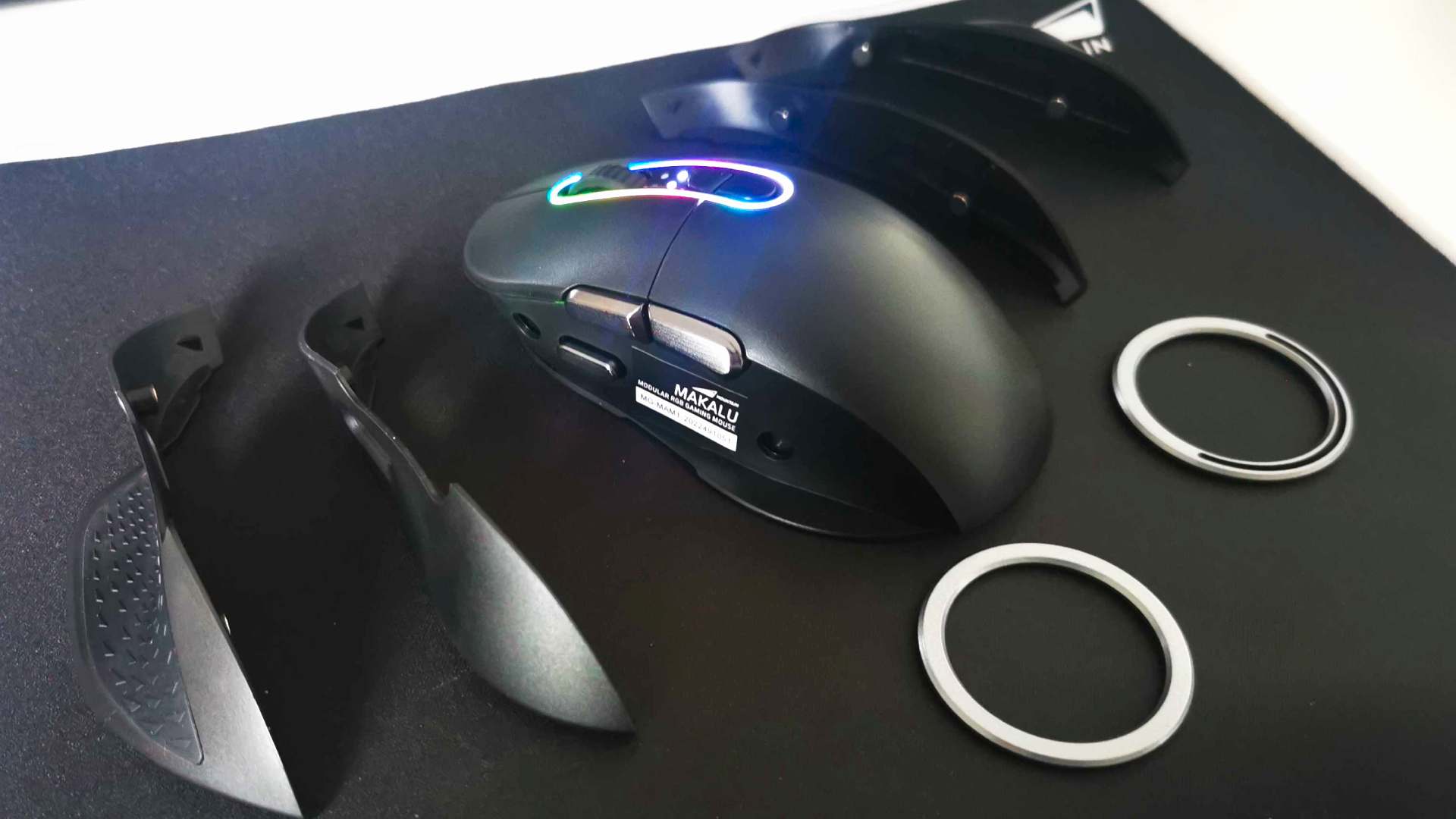Our Verdict
Magnificent modularity helps the Mountain Makalu Max secure a place at the top of the gaming mouse chain, but its subtle approach is perhaps a bit off-brand for the company.
Prior to making the climb through our Mountain Makalu Max review, I thought I knew what to expect from the company’s modular gaming mouse. In my mind, I figured it’d have fancy add-ons like extra buttons, dials, and things that you wouldn’t usually find attached to a PC clicker. In reality, it features none of those and instead serves as a reliable rodent that can morph to suit situational ergonomic needs. Is that a bad thing? Hell no, and it actually means its substance isn’t overshadowed by needless style.
Coming in at $89.99, the Mountain Makalu Max isn’t cheap, but it doesn’t quite sit atop the price peak. That’s not to say it can’t keep up with the best gaming mouse options out there, and its specs shine bright among pricer competitors. Perhaps ‘competitors’ isn’t the proper term, as I can’t think of an alternative that’s morphable in quite the same way, with only the swappable faceplates of the Razer Naga Trinity springing to mind.
Mountain is relatively new to this rat race, and we consider the company to be a keyboard pioneer. As such, it’s hard to not feel just a tad disappointed that the Makalu Max doesn’t go over the top with add-ons. Sensible, adult, me knows this is for the best, but the chaotic child dwelling within wants something that looks like a proper Mountain Everest Max counterpart. That said, the company’s first mouse, the Makalu 67, is comparatively quite bland, so perhaps the company is building up to something more flamboyant.
If you’d rather take shortcuts, I’ve included some handy links that’ll serve as a Funicular to specific parts of our Mountain Makalu Max review:
Mountain Makalu Max specs
Before we delve into Mountain’s modular magic tricks, let’s talk specs. The Makalu Max is a wireless mouse that wields a 19,000 DPI PixArt PAW3370 sensor. The rodent cuts the cord with 2.4GHz connectivity and provides the usual USB-C wired fallback, but doesn’t embrace the alternative benefits of Bluetooth. Personally, I don’t consider that to be a dealbreaker, but it may matter to those of you who like to switch between the PC and devices like the Steam Deck or the newly released Asus ROG Ally.
| Mountain Makalu Max specs | |
| Sensor | DPI PixArt PAW3370 |
| DPI | 19,000 |
| Buttons | 6 |
| Connectivity | 2.4GHz, USB-C |
| Weight | Variable |
As for clickiness, Mountain has that covered with its Kailh GM 8.0 microswitches, which the company describes as “cream of the crop.” That claim should translate to no misclicks and premium grade accuracy, and they hold up against Cherry and Omron switches.
Mountain Makalu Max features
It’s safe to say that modularity is the Mountain Makalu Max’s biggest selling point, but it’s anything but a gimmick. Rather than opting for something showboaty, the peripheral maker has adopted a system that lets you completely change the shape of the mouse using magnetic side panels. Again, that may sound a little boring given it comes from the same folks that made the Mountain Everest Max keyboard, but practicality absolutely trumps pageantry this time around.
The default sides easily pull away from the Makalu Max, and you’ll find two alternative panels in the box. Whether you require a little extra thumb support or need something wider for your palms, Mountain’s mighty mouse can morph to suit. In a sense, this is a PC peripheral that has the potential to change alongside its owner, as you’ll be able to switch things up if you develop ergonomic requirements.
A great gaming mouse also isn’t necessarily good for productivity, and Mountain seems to understand that unavoidable fact. Admittedly, I’ll happily use something designed for gunning down digital opponents to click a spreadsheet to death, but I can why someone would want to use one shape during the day and another during play. Of course, that more applies to those of you out there that work from home, as your in-office mouse is a clicky colleague you likely don’t invite to your FPS game sessions.
In addition to modular magnificence, the Mountain Makalu Max uses a ‘gravity control system’ to facilitate customizable weight. Included in the box are 6.6g, 8.4g, and, 10.8g metal disks that friction fit underneath the peripheral, with cutouts on each also serving as a way to rebalance. If you’re looking for a superlight mouse, you’ll likely leave these handy circles in the box, but their inclusion provides another appreciated layer of customization that contributes to the mouse’s versatility quest.
Annoyingly, the left-side up, down, and ‘sniper’ buttons are fixed to the mouse, and the panels cater to right-hand users. This feels like a missed opportunity, as the Makalu Max’s modularity could have covered all bases if it took this into consideration. Simply put, if you’re looking for a left-handed gaming mouse, you’ll either need to use the default Makalu Max attachments and ignore the side buttons, or search for something else.
Mountain Makalu Max design
It’s needless to say that features dictate the design when it comes to the Makalu Max, as modularity drastically changes its appearance. However, that’s not to say there isn’t Mountain DNA to be found at its core, as it follows the same principles as the company’s other peripherals.
High-quality plastic provides the mouse with a mighty fine feel and finish, while a striking RGB accent around the scroll wheel adds subtle flair to the mix. Sure, it’s not as visually interesting to look at as something like the Roccat Kone XP Air, but it still does enough to avoid looking like a conservative rodent.
Circling back to the modular side of things, Mountain’s approach to the hardware mechanic is solid. Strong, but easy-to-remove magnets keep those aforementioned side panels firmly in place, and the friction-fit weighted rings are easier to swap out than the ones on classic mice like the Corsair M65 RGB Elite.
Mountain Makalu Max performance
I’m not, and never will be, an esports pro, but that’s not to say I don’t respect the Makalu Max’s performance provisions. Mountain’s switches of choice feel satisfyingly accurate, with each audible click resulting in responsive shots in every shooter I could think to try, including new releases like Redfall. Arkane’s vampire-infested shooter is far from being an ideal experience, but using the Makalu Max to gun down the undead made my brief playthrough of the game a little more bearable.
The Makalu Max’s sensor really shines through, too, facilitating quick whip-around movement in first-person scenarios. Smaller things, like wider glides, also contribute to smoothness, and being able to balance things using weights is a godsend for those who are used to chucking around a specific mouse.
If required, you can toggle sensitivity using two top buttons, and the max setting should accommodate pros looking for lightning-fast accuracy. It’s worth noting that more expensive alternatives like the Razer Basilisk V3 Pro boast a much higher DPI, but I’d argue there’s probably no need to spend money on a 30K sensor unless you’re competing at a professional level.
Mountain Makalu Max battery life
Battery life is an obvious biggie when it comes to wireless peripherals, and Makalu Max doesn’t let the side down. Mountain claims the mouse can keep on running for up to 80 hours, but the figure is naturally based on ditching RGB and minimal usage. In practice, I was able to squeeze a day or two of general usage out of the Makalu Max before having to plug it in, which is fairly impressive given that I seemingly cannot grasp the concept of an off switch.
This is perhaps a wider criticism of the wider gaming mouse nest, but I’d really appreciate better indicators that inform you of how much theoretical battery life you’ve got left. The Makula Max will warn you with menacing red LEDs when things are critical, but as someone who has no awareness of time, I’d find a time-based meter extremely helpful, even if it’s featured within software settings.
That’s not to say there aren’t ways to protect battery life from neurospicy brains like my own, as there are handy wake-up and sleep options available within the Base Camp app. I’m pretty sure that if it wasn’t for these settings, I’d end up having to scramble for a USB cable more often, and they contribute to the device’s working day longevity.
Mountain Makalu Max software
Like with most PC peripherals, software ties the experience together, you’ll need to download the Mountain Base Camp app to customize and fine-tune the Makalu Max. In terms of UI, the toolkit is fairly minimalist, and accessing profiles and RGB options, all while offering up a pretty effective way to record custom macros.
Base Camp provides various sliders and dials relating to sensitivity, speed, and responsiveness, and I’d say it there are enough options to fully tailor your experience.
I know I’ve already touched on battery indicator wishes, but happens to be one of my only gripes with the Base Camp app, as it doesn’t show up in your system tray. Instead, you’ll have to open the program and glance at the device menu, where you’ll find the mouse listed alongside any other Mountain peripherals connected to your PC.
Mountain Makalu Max verdict
It ain’t flashy, but the Mountain Makalu Max is a modular gaming mouse that sits among the best. Rather than going all out with specific attachments no one actually asked for, the company has created a clicker that can become exactly what you need it to be, whether you need a chonky ergonomic champion or a sleekit wee beastie that’s trim and light.
I do, however, think Mountain could have dipped more than its toes in the customization waters while still maintaining subtle functionality. Including perhaps an optional MMO keypad attachment would have placed it in the same rings as the Razer Naga Trinity, but I guess the mouse maker could embark on that particular climb at a later date.
Pros:
- Modular side panels
- Adjustable weight
- Striking RGB
Cons:
- Not as flashy as Mountain’s keyboards
- Missed opportunity to be ambidextrous








